Jeremy Straub
Incorporation of Verifier Functionality in the Software for Operations and Network Attack Results Review and the Autonomous Penetration Testing System
Sep 13, 2024



Abstract:The software for operations and network attack results review (SONARR) and the autonomous penetration testing system (APTS) use facts and common properties in digital twin networks to represent real-world entities. However, in some cases fact values will change regularly, making it difficult for objects in SONARR and APTS to consistently and accurately represent their real-world counterparts. This paper proposes and evaluates the addition of verifiers, which check real-world conditions and update network facts, to SONARR. This inclusion allows SONARR to retrieve fact values from its executing environment and update its network, providing a consistent method of ensuring that the operations and, therefore, the results align with the real-world systems being assessed. Verifiers allow arbitrary scripts and dynamic arguments to be added to normal SONARR operations. This provides a layer of flexibility and consistency that results in more reliable output from the software.
Initial Development and Evaluation of the Creative Artificial Intelligence through Recurring Developments and Determinations (CAIRDD) System
Sep 03, 2024Abstract:Computer system creativity is a key step on the pathway to artificial general intelligence (AGI). It is elusive, however, due to the fact that human creativity is not fully understood and, thus, it is difficult to develop this capability in software. Large language models (LLMs) provide a facsimile of creativity and the appearance of sentience, while not actually being either creative or sentient. While LLMs have created bona fide new content, in some cases - such as with harmful hallucinations - inadvertently, their deliberate creativity is seen by some to not match that of humans. In response to this challenge, this paper proposes a technique for enhancing LLM output creativity via an iterative process of concept injection and refinement. Initial work on the development of the Creative Artificial Intelligence through Recurring Developments and Determinations (CAIRDD) system is presented and the efficacy of key system components is evaluated.
Development of an AI Anti-Bullying System Using Large Language Model Key Topic Detection
Aug 19, 2024
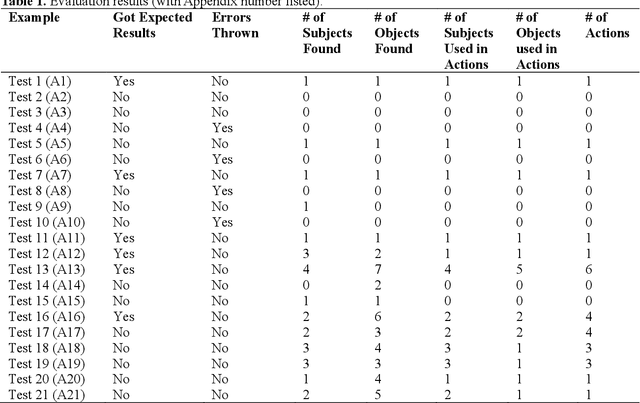
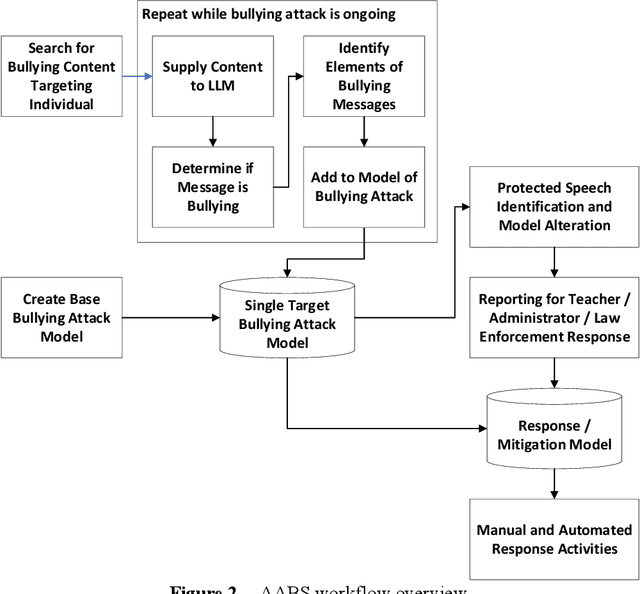
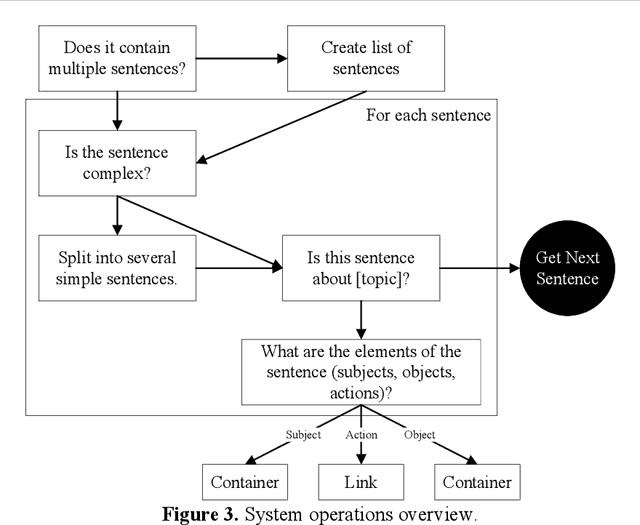
Abstract:This paper presents and evaluates work on the development of an artificial intelligence (AI) anti-bullying system. The system is designed to identify coordinated bullying attacks via social media and other mechanisms, characterize them and propose remediation and response activities to them. In particular, a large language model (LLM) is used to populate an enhanced expert system-based network model of a bullying attack. This facilitates analysis and remediation activity - such as generating report messages to social media companies - determination. The system is described and the efficacy of the LLM for populating the model is analyzed herein.
Development of REGAI: Rubric Enabled Generative Artificial Intelligence
Aug 05, 2024Abstract:This paper presents and evaluates a new retrieval augmented generation (RAG) and large language model (LLM)-based artificial intelligence (AI) technique: rubric enabled generative artificial intelligence (REGAI). REGAI uses rubrics, which can be created manually or automatically by the system, to enhance the performance of LLMs for evaluation purposes. REGAI improves on the performance of both classical LLMs and RAG-based LLM techniques. This paper describes REGAI, presents data regarding its performance and discusses several possible application areas for the technology.
Development of an Adaptive Multi-Domain Artificial Intelligence System Built using Machine Learning and Expert Systems Technologies
Jun 17, 2024


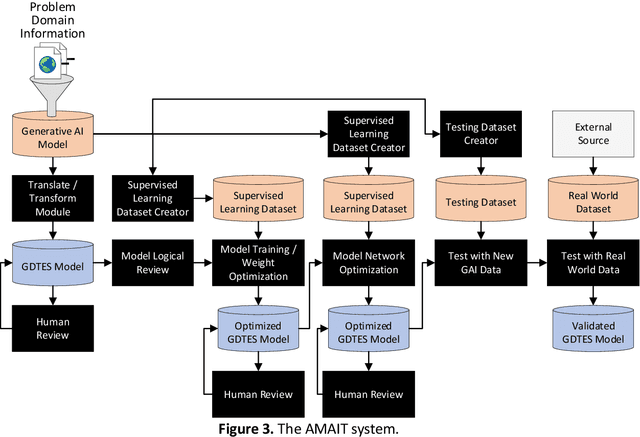
Abstract:Producing an artificial general intelligence (AGI) has been an elusive goal in artificial intelligence (AI) research for some time. An AGI would have the capability, like a human, to be exposed to a new problem domain, learn about it and then use reasoning processes to make decisions. While AI techniques have been used across a wide variety of problem domains, an AGI would require an AI that could reason beyond its programming and training. This paper presents a small step towards producing an AGI. It describes a mechanism for an AI to learn about and develop reasoning pathways to make decisions in an a priori unknown domain. It combines a classical AI technique, the expert system, with a its modern adaptation - the gradient descent trained expert system (GDTES) - and utilizes generative artificial intelligence (GAI) to create a network and training data set for this system. These can be created from available sources or may draw upon knowledge incorporated in a GAI's own pre-trained model. The learning process in GDTES is used to optimize the AI's decision-making. While this approach does not meet the standards that many have defined for an AGI, it provides a somewhat similar capability, albeit one which requires a learning process before use.
Implementation and Evaluation of a Gradient Descent-Trained Defensible Blackboard Architecture System
Apr 17, 2024Abstract:A variety of forms of artificial intelligence systems have been developed. Two well-known techniques are neural networks and rule-fact expert systems. The former can be trained from presented data while the latter is typically developed by human domain experts. A combined implementation that uses gradient descent to train a rule-fact expert system has been previously proposed. A related system type, the Blackboard Architecture, adds an actualization capability to expert systems. This paper proposes and evaluates the incorporation of a defensible-style gradient descent training capability into the Blackboard Architecture. It also introduces the use of activation functions for defensible artificial intelligence systems and implements and evaluates a new best path-based training algorithm.
Development of an Autonomous Reverse Engineering Capability for Controller Area Network Messages to Support Autonomous Control Retrofits
Jul 20, 2023


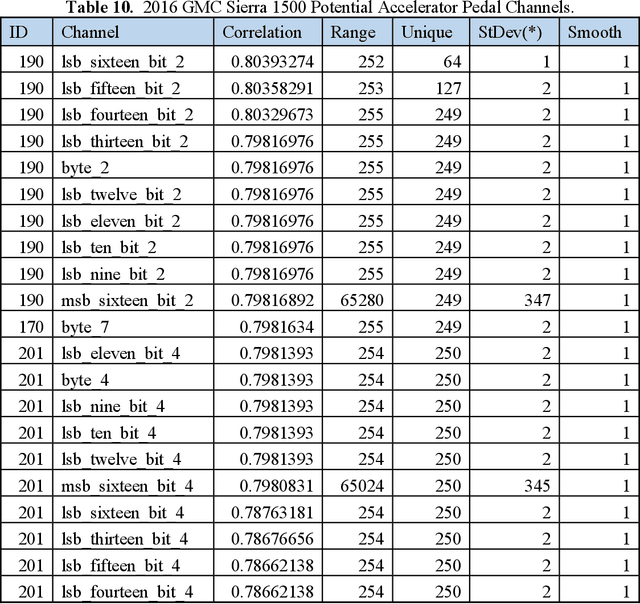
Abstract:As the autonomous vehicle industry continues to grow, various companies are exploring the use of aftermarket kits to retrofit existing vehicles with semi-autonomous capabilities. However, differences in implementation of the controller area network (CAN) used by each vehicle manufacturer poses a significant challenge to achieving large-scale implementation of retrofits. To address this challenge, this research proposes a method for reverse engineering the CAN channels associated with a vehicle's accelerator and brake pedals, without any prior knowledge of the vehicle. By simultaneously recording inertial measurement unit (IMU) and CAN data during vehicle operation, the proposed algorithms can identify the CAN channels that correspond to each control. During testing of six vehicles from three manufacturers, the proposed method was shown to successfully identify the CAN channels for the accelerator pedal and brake pedal for each vehicle tested. These promising results demonstrate the potential for using this approach for developing aftermarket autonomous vehicle kits - potentially with additional research to facilitate real-time use. Notably, the proposed system has the potential to maintain its effectiveness despite changes in vehicle CAN standards, and it could potentially be adapted to function with any vehicle communications medium.
Extension of the Blackboard Architecture with Common Properties and Generic Rules
Jun 07, 2023Abstract:The Blackboard Architecture provides a mechanism for embodying data, decision making and actuation. Its versatility has been demonstrated across a wide number of application areas. However, it lacks the capability to directly model organizational, spatial and other relationships which may be useful in decision-making, in addition to the propositional logic embodied in the rule-fact-action network. Previous work has proposed the use of container objects and links as a mechanism to simultaneously model these organizational and other relationships, while leaving the operational logic modeled in the rules, facts and actions. While containers facilitate this modeling, their utility is limited by the need to manually define them. For systems which may have multiple instances of a particular type of object and which may build their network autonomously, based on sensing, the reuse of logical structures facilitates operations and reduces storage and processing needs. This paper, thus, presents and assesses two additional concepts to add to the Blackboard Architecture: common properties and generic rules. Common properties are facts associated with containers which are defined as representing the same information across the various objects that they are associated with. Generic rules provide logical propositions that use these generic rules across links and apply to any objects matching their definition. The potential uses of these two new concepts are discussed herein and their impact on system performance is characterized.
Introduction and Assessment of the Addition of Links and Containers to the Blackboard Architecture
Jun 07, 2023Abstract:The Blackboard Architecture provides a mechanism for storing data and logic and using it to make decisions that impact the application environment that the Blackboard Architecture network models. While rule-fact-action networks can represent numerous types of data, the relationships that can be easily modeled are limited by the propositional logic nature of the rule-fact network structure. This paper proposes and evaluates the inclusion of containers and links in the Blackboard Architecture. These objects are designed to allow them to model organizational, physical, spatial and other relationships that cannot be readily or efficiently implemented as Boolean logic rules. Containers group related facts together and can be nested to implement complex relationships. Links interconnect containers that have a relationship that is relevant to their organizational purpose. Both objects, together, facilitate new ways of using the Blackboard Architecture and enable or simply its use for complex tasks that have multiple types of relationships that need to be considered during operations.
Automating the Design and Development of Gradient Descent Trained Expert System Networks
Jul 04, 2022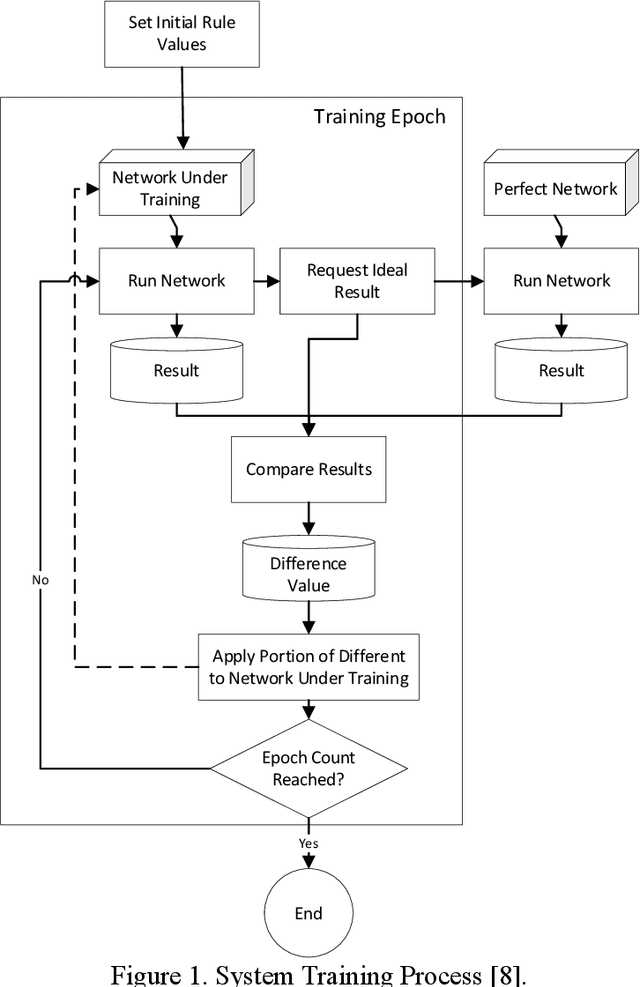
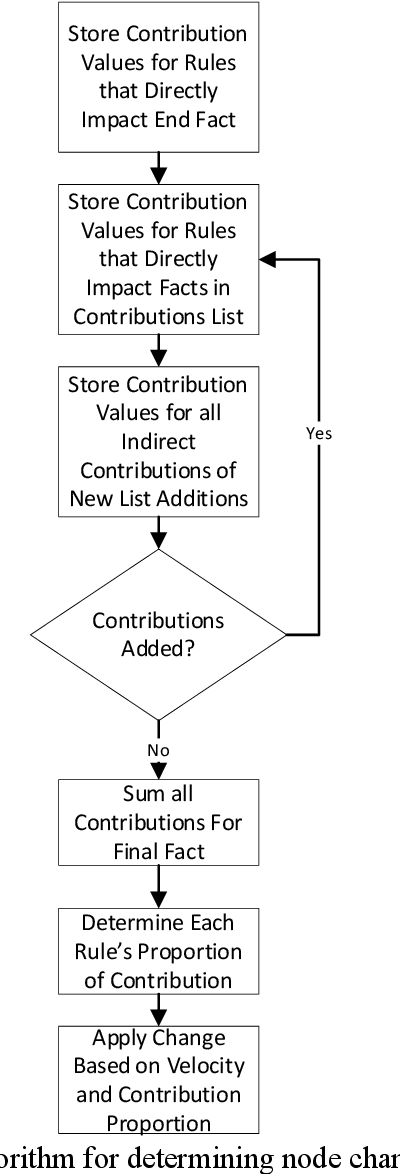

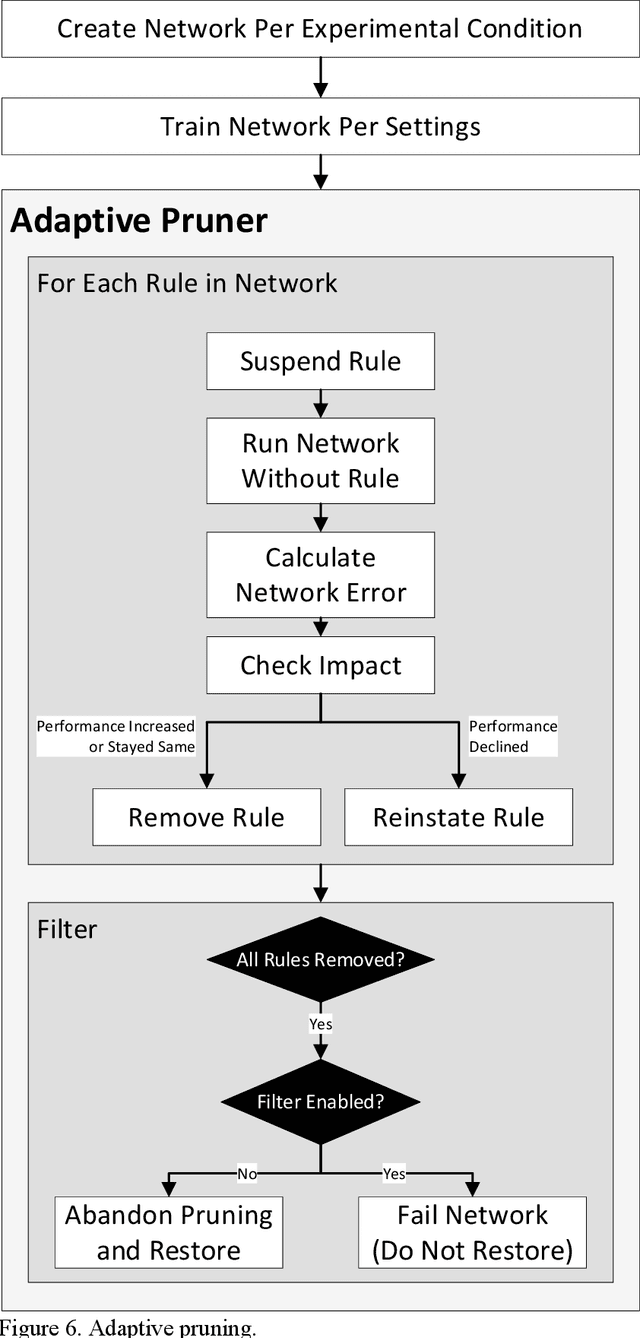
Abstract:Prior work introduced a gradient descent trained expert system that conceptually combines the learning capabilities of neural networks with the understandability and defensible logic of an expert system. This system was shown to be able to learn patterns from data and to perform decision-making at levels rivaling those reported by neural network systems. The principal limitation of the approach, though, was the necessity for the manual development of a rule-fact network (which is then trained using backpropagation). This paper proposes a technique for overcoming this significant limitation, as compared to neural networks. Specifically, this paper proposes the use of larger and denser-than-application need rule-fact networks which are trained, pruned, manually reviewed and then re-trained for use. Multiple types of networks are evaluated under multiple operating conditions and these results are presented and assessed. Based on these individual experimental condition assessments, the proposed technique is evaluated. The data presented shows that error rates as low as 3.9% (mean, 1.2% median) can be obtained, demonstrating the efficacy of this technique for many applications.
 Add to Chrome
Add to Chrome Add to Firefox
Add to Firefox Add to Edge
Add to Edge